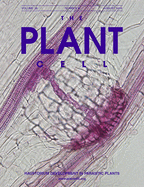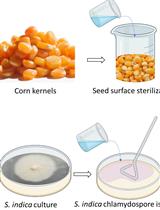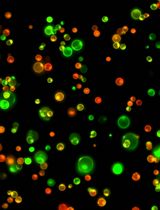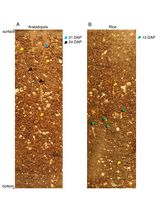- EN - English
- CN - 中文
Haustorium Induction Assay of the Parasitic Plant Phtheirospermum japonicum
寄生植物日本松蒿的吸器诱导测定
发布: 2017年05月05日第7卷第9期 DOI: 10.21769/BioProtoc.2260 浏览次数: 10211
评审: Marisa RosaXinyan ZhangAnonymous reviewer(s)
Abstract
Phtheirospermum japonicum is a facultative root parasitic plant in the Orobanchaceae family used as a model parasitic plant. Facultative root parasites form an invasive organ called haustorium on the lateral parts of their roots. To functionally characterize parasitic abilities, quantification of haustorium numbers is required. However, this task is quite laborious and time consuming. Here we describe an efficient protocol to induce haustorium in vitro by haustorium-inducing chemicals and host root exudate treatments in P. japonicum.
Keywords: Parasitism (寄生)Background
Parasitic plants have evolved to obtain nutrients from other plants. Some of parasitic plants cause significant damage to agriculture by infecting commercial crops (Spallek et al., 2013). Obligate parasitic plants require hosts to complete their lifecycle, while facultative parasitic plants can survive without hosts as autotrophic organisms but shift to heterotrophic by infection if host plants are nearby (Westwood et al., 2010). The common characteristic of all parasitic plants is a specialized organ called haustorium, which connects parasite with host by establishing vascular bridges (Saucet and Shirasu, 2016; Yoshida et al., 2016). Obligate root parasites form terminal haustoria that are derived from enlarged root tips, while facultative root parasites form lateral haustoria, which develop at the lateral side of the parasite roots without affecting the root meristem. Therefore, several lateral haustoria can form in a root. The early stage of haustorium development is characterized by enlarged root tissues caused by a combination of cell expansion and cell division. Several host-derived substances that are able to induce haustorium formation in vitro were previously identified. Such substances are called haustorium-inducing factors (HIF). Among them, the most active HIF is DMBQ (2,6-Dimethoxy-1,4-benzoquinone), initially isolated from sorghum root extracts (Chang and Lynn, 1986). Phtheirospermum japonicum, a facultative parasitic plant in the Orobanchaceae, is an ideal model to study the molecular mechanisms of the parasitism, because of its short life cycle, small size, and simple genetics as a selfing plant (Ishida et al., 2011; Cui et al., 2016). In addition, genetic manipulation of P. japonicum is now feasible (Ishida et al., 2011) and its large-scale transcriptome information is also available (Ishida et al., 2016). Here we report an efficient in vitro method for haustorium induction to investigate functionality of haustorium-related genes in P. japonicum. This method presents a step-by-step protocol for haustorium induction in vitro by DMBQ treatment or by contact with host exudates. This technique is useful to understand the genetic factors that trigger haustorium formation in parasitic plants.
Materials and Reagents
- Falcon 50 ml conical centrifuge tube (e.g., Corning, Falcon®, catalog number: 352070 )
- Filter paper, No. 2, Ø9 cm (Advantec, catalog number: 00021090 )
- Sterilized plastic plate dish with diameter of 100 mm (e.g., BioLite φ100 TC Dish, Fisher Scientific, catalog number: 12-556-002 )
Manufacturer: Thermo Fisher Scientific, Thermo ScientificTM, catalog number: 130182 . - Eppendorf® microcentrifuge tube (1.5 ml) (e.g., Fisher Scientific, catalog number: 05-408-129 )
- Surgical tape (or Parafilm) (e.g., 3M, catalog number: 1530-1 )
- Kitchen aluminium foil
- Sterilized square plastic plate dish 140 x 100 x 14.5 mm (Eiken Chemical, catalog number: AW2000 703077 )
- Microscope slides (e.g., Fisher Scientific, catalog number: 12-549-3 )
- Microscope coverslips L x W x D: 22 x 70 x 1.0 mm (e.g., Fisher Scientific, catalog number: 10-016-24 )
- Gloves
- Rice seeds (Oryza sativa japonica variety Nipponbare)
- Phtheirospermum japonicum seeds
- Commercial hypochlorite solution (Kao Japan) (approx. 6% sodium hypochloride)
- Potassium hydroxide (KOH) (Sigma-Aldrich, catalog number: 484016 )
- Tween 20 (Sigma-Aldrich, catalog number: P9416 )
- Water (Milli-Q grade)
- Propidium iodide (Sigma-Aldrich, catalog number: P4170 )
- Murashige and Skoog salts (Pre-mixed) (Wako Pure Chemical Industries, catalog number: 392-00591 )
- Sucrose (Merck Millipore, catalog number: 107687 )
- Myo-inositol (Sigma-Aldrich, catalog number: I7508 )
- 2,6-dimethoxy-1,4-benzoquinone (DMBQ) (Sigma-Aldrich, catalog number: 428566 )
- Agar (Merck Millipore, catalog number: 101614 )
- Dimethyl sulfoxide (DMSO) (Wako Pure Chemical Industries, catalog number: 041-29351 )
- Chloral hydrate (Sigma-Aldrich, catalog number: V000554 )
- Glycerol (Sigma-Aldrich, catalog number: G5516 )
- GM media (see Recipes)
- DMBQ stock solution (10 mM) (see Recipes)
- Chloral hydrate solution (see Recipes)
Equipment
- Rice husker (Fujiwara Scientific, model: Testing rice husker )
- Tube rotator (e.g., TITEC, model: RT-50 , catalog number: 0000165-000)
- Laminar flow hood (e.g., YAMATO SCIENTIFIC, model: CCV-1300E )
- Plant growth chamber (e.g., NKsystem, model: LPH-411SP )
- Daylight-white fluorescent lamp (NEC LIGHTING, model: FL40SEX-N-HG )
- Microscope (Leica Microsystems, model: TCS-SP5 II )
- Vortex shaker (e.g., Scientific Industries, model: Vortex-Genie2 , catalog number: G560-SI-0246 2)
- Surgical scalpel handle (e.g., Swann-Morton, catalog number: 0933 )
- Surgical scalpel blade number 11 (e.g., Swann-Morton, catalog number: 0303 )
- Stainless steel forceps (e.g., Sigma-Aldrich, catalog number: F4142-1EA )
- Semi-analytical balance (e.g., Shimadzu, model: AUW220D )
- Water bath (e.g., Fisher Scientific, model: Fisher ScientificTM IsotempTM General Purpose Deluxe Water Bath, catalog number: S28124 )
- Light stereo microscope (e.g., Carl Zeiss, model: Stemi-2000 )
- Light microscope (e.g., Olympus, model: BX53-P )
- Autoclave (e.g., Hirayama, model: HG series )
Procedure
文章信息
版权信息
© 2017 The Authors; exclusive licensee Bio-protocol LLC.
如何引用
Ishida, J. K., Yoshida, S. and Shirasu, K. (2017). Haustorium Induction Assay of the Parasitic Plant Phtheirospermum japonicum. Bio-protocol 7(9): e2260. DOI: 10.21769/BioProtoc.2260.
分类
植物科学 > 植物生理学 > 生物胁迫
植物科学 > 植物生理学 > 表型分析
您对这篇实验方法有问题吗?
在此处发布您的问题,我们将邀请本文作者来回答。同时,我们会将您的问题发布到Bio-protocol Exchange,以便寻求社区成员的帮助。
Share
Bluesky
X
Copy link
















